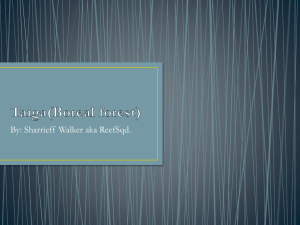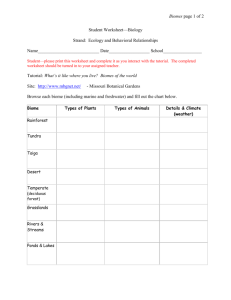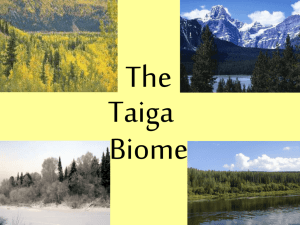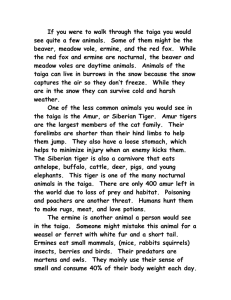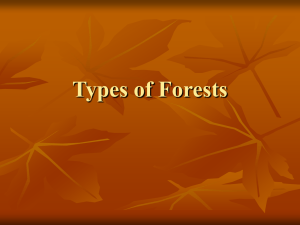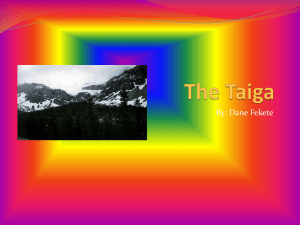Taiga Biome
advertisement
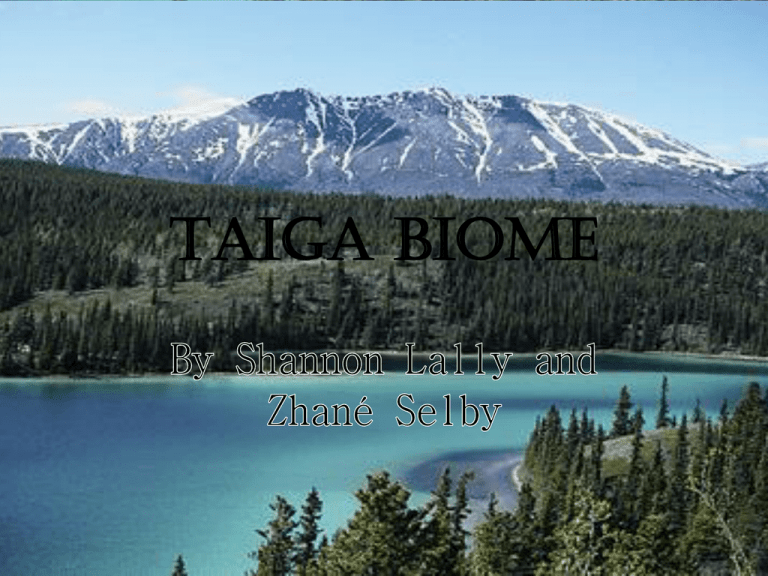
Taiga Biome Geographic Range • The taiga biome is restricted to areas between fifty degrees latitude north and the Arctic Circle. Though restricted by latitude, the taiga is not restricted by longitude. • The taiga biome exists in both the eastern and western hemispheres, the largest of which being in Russia. • Other areas in which the taiga is prominent are Siberia, Alaska, Canada, and Scandinavia. Temperature • In the winter, temperatures in the taiga vary. On average, the temperature is anywhere between between -65 and 30 degrees. • In the summer, temperatures range from 27 to 70 degrees. • On average, the temperature is below freezing in the taiga year round. Climate • Wind from the Arctic Circle blows downward, bringing bitterly cold temperatures. • Temperatures decrease drastically on cold nights with little to no cloud coverage. • Winter is the longest season and lasts between six and seven months. • Fall is the shortest season. Precipitation • The average annual amount of snowfall in the taiga is 20-40 inches. • On average, the taiga experiences 10-20 inches of rainfall. • The average annual amount of overall precipitation is 40 inches. Soil Types • Due to the extremely cold temperature in the taiga, there is a layer of permafrost, or permanently frozen soil underground. • A layer of bedrock is also present, and the bedrock combined with the permafrost prevents water from draining from the first few layers of soil. • The presence of the excess water creates muskegs. Muskegs are shallow bogs that look like solid ground and are often covered by short grasses, trees, and mosses. Life Forms/Sample Populations Animals • Moose • Lynx • Bears • Wolverines • Foxes • Squirrels • Wolves Plants • Coniferous trees • Pines trees • Oaks trees • Maple trees • Elm trees The taiga is home of the needle leaf forest regions. Abiotic Factors • Extreme weather • Hard soil types keeping water from draining • Extreme snowfall Keystone Species • Wolves are a keystone species. – When wolves are killed off, the species wolves keep in check are allowed to reproduce freely, and resources become scarce. Adaptations • Animals like moose and wolves have thick coats for warmth. • Hares camouflage themselves to hide from predators, and their coats change from brown to white in the winter and vice versa. • Bears hibernate in the winter. • Owls have sharp predatory claws for hunting in the snow. Adaptations Continued • Moose have long legs for walking through the snow. • Birds migrate to warmer areas during cold winter months. • Plants have smooth waxy coatings to help retain water and shed ice. Examples of Symbiosis • Mutualistic – Moss growing on a tree. The tree houses the moss, and the moss protects the bark on the tree • Parasiticism – Grape vines become hosts for aphids and die. • Commensalism – Fungi feeds off of dead trees. The trees are dead and therefore not harmed. Population Density and Growth • Density –Independent limiting factors: Weather- cold temperatures, and excessive precipitation –Dependent limiting factors: Competition for resources, like food. Carbon and Nitrogen Cycles Carbon Cycle Nitrogen Cycle Carbon Cycle • In the beginning of the carbon cycle, carbon gets taken in in the form of carbon dioxide by producers who need carbon for photosynthesis. This carbon then gets turned into sugar inside the plant (photosynthesis). Then, the producer either dies and decomposes, or the plant gets eaten by a consumer, and the carbon gets passed up the food chain. When the plant or final consumer to eat an organism containing the same carbon as the plant dies, decomposers break down the remains and release the carbon back into the atmosphere through cellular respiration. Sometimes, carbon goes directly to the soil after the plant or animal dies, and in that case, the carbon is stored as a fossil fuel and released through combustion. Either way, the carbon ends up back in the atmosphere, ready to go through the carbon cycle again. Without carbon, the organisms could not survive because there would be no sugars for energy. The carbon cycle ensures that carbon is used and reused efficiently. Producers take in carbon for photosynthesis. The carbon gets turned into sugars, and the grass and carbon are consumed by a moose. The moose is then consumed by a wolf, which transfers the carbon up the food chain. Eventually, the wolf dies, and decomposers break down the carcass and release the carbon back into the atmosphere. Nitrogen Cycle • • • • • • • Nitrogen is used in chlorophyll, amino acids, and nucleic acid. Without these, photosynthesis could not occur, and organisms would not be able to live. Every organism needs nucleic and amino acids. The nitrogen cycle ensures the most efficient use of the nitrogen and recycles it to allow for the survival of living organisms. The nitrogen cycle occurs in several stages. In the first step, fixation, nitrogen is turned into ammonium by nitrogen-fixing bacteria. These bacteria often live in the roots of plants, most commonly legumes, such as peas and beans. Bacteria then must alter the nitrogen yet again by turning the new ammonium into nitrate. Plants are able to utilize nitrate, unlike nitrogen and ammonium (nitrification). For the nitrate to be used in chlorophyll, nucleic acids, and amino acids, the nitrate must be absorbed through the roots of the plant. The plant then uses the nitrogen, or the plant is eaten by a consumer, which passes on the nitrogen (assimilation). Decomposers and bacteria transform the nitrogen in dead organisms back into ammonium so that the nitrate can be reused (ammonification). Bacteria push nitrogen not currently being used in the soil into the atmosphere (denitrificatin). Atmospheric nitrogen would be taken in from the soil into the roots of Trifolium pratense (a legume) which is where nitrogen-fixing bacteria live. These bacteria would turn the nitrogen into ammonium, and then they would turn the ammonium into nitrate. The nitrate would be absorbed by the plant roots and used within the plant cell's. Either the nitrogen remains within the cell, or it is transferred to a consumer that ate the plant, like a moose. After the moose or the plant dies, bacteria and fungi, like lichen, turn the nitrogen back into ammonia to be recycled back into the nitrogen cycle. Finally, bacteria in the soil push excess unused nitrogen from the soil back into the atmosphere. Factors Biotic Abiotic • • Biotic factors are living organisms that have an impact on their environment. Such organisms are moose, bears, wolves, spruce trees, evergreen trees, and many more. Each organisms plays an important role in the food and energy web as a producer, consumer, or decomposer. The plant life also has a huge impact on the biome and the survival of other organisms. Trees are a source of food and shelter, but they also block sunlight and prevent some other plants from being able to grow. Every organism plays its part in the food web and dynamic in the taiga. Abiotic factors are nonliving and inanimate objects that also have an impact on the dynamic of life in the ecosystem. Some abiotic factors that play a large role in the taiga are sunlight, large amounts of precipitation, and soil types. Sunlight is one of the major components of photosynthesis in producers. Without sunlight, plants are unable to produce glucose, and the consumers in the area will compete over limited resources or starve. The taiga has limited sunlight in some areas due to the dense growth of trees that allows little light to reach the ground. Precipitation is another major abiotic factor. The taiga experiences over 20-40 inches of snowfall every year. This gargantuan amount of snowfall not only kills plants beneath the surface of the snow, but also kills the consumers that starve to death. The surface of the taiga is dangerous, but what's below the surface can be just as dangerous. The layer of permafrost not only interferes with plant root systems, but it also causes flooding that kills vegetation when the snow melts in the spring. Symbiosis • Symbiosis is a close association relationship between at least two organisms. Sometimes symbiosis benefits both organisms, and sometimes it doesn't. • Mutualistic- In mutualistic symbiosis, both organisms benefit from the relationship. One example of this relationship in the taiga is moss growing on a tree. Not only is the moss housed and protected by the tree, but the tree's bark is shielded by the moss growing on it. • Parasitic- In parasitic symbiosis, one organisms gains something, like nutrients, at the expense of the other. For example, in the taiga, the grape vine becomes host for and is killed by the aphid, otherwise known as the grapevine aphid. • Commensalism- In commensalism, one organism gains nutrients without harming the other. An example of this in the taiga is when fungi breaks down a decaying tree. The decomposer is gaining nutrients, but the tree is already dead, so no harm is being done. Food Web/Energy Flow • At the bottom of the food pyramid/web are the primary producers, such as grass, moss, and the white spruce tree. These producers are then consumed by primary consumers, such as hares, red squirrels, or moose, or they are broken down by decomposers (fungi). If it is broken down by a fungi, the energy from the plant will be passed on to a primary consumer that eats the fungi, like the red squirrel. The primary consumers will then be consumed by either secondary or tertiary consumers. Secondary consumers include great horned owls, red foxes, and weasels, and tertiary consumers include wolves, lynxes, and grizzly bears. Food Web Human Impact • Recently, efforts have been made by humans to save forests, including the taiga. Logging in forests has led to deforestation, which leads to the displacement, endangerment, and possible extinction of species who are native to the area. Hunting is also a major problem in the taiga. The Siberian tiger, due to logging and poaching, is a critically endangered species. Species are beginning to dwindle and disappear. The perhaps most dangerous effect of human activity in the taiga is acid rain. The excessive burning of fossil fuels pollutes the soil and water and harms both plants and animals native to the area. Siberian Tiger Natural Selection • In the taiga biome, nature favors those who can withstand the cold. Only the trees with waxy needle-like leaves are able to retain enough water to survive. Spruce trees, evergreen trees, fir trees, and pine trees are all favored in this environment because of their needles. Mammals with thick fur are more likely to survive in the taiga. Moose, wolves, foxes, lynx, and rabbits all have thick fur to keep warm. This is the reason why lizards are rarely found in the taiga: they are cold blooded and unable to stay warm. Other traits that are advantageous to taiga organisms are long legs and sharp talons. Large mammals, such as moose and caribou, have long legs for traversing through deep snow. Birds, such as owls, have long, sharp talons specially designed for hunting prey in snowy conditions. Then, within each species, there are advantages that lead to more reproduction. One instance of intrasexual selection occurs in moose. The larger the antlers are, the larger the males are that the moose can take on in competition for females and reproduction. Although the large antlers slow the moose down, they lead to more reproduction.
